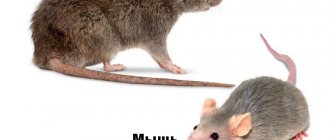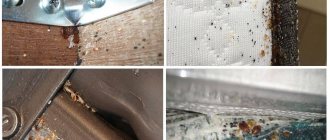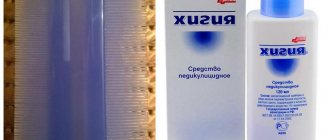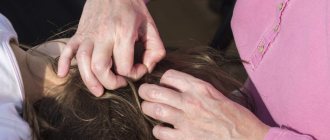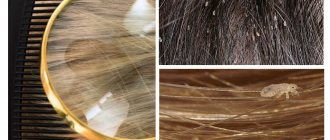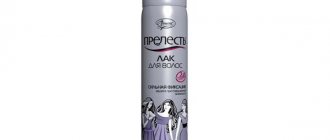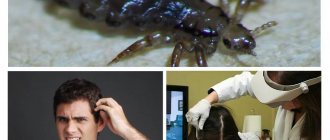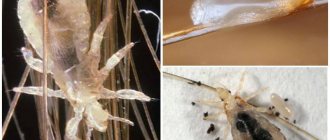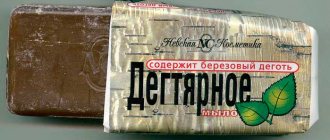Capsules from the embryo - what are they?
There are several types of lice in nature, but the most common louse is the head louse. When it lands on a person's head, it quickly begins to lay its eggs - nits, attaching them to the hairs using its glue. Read on our website in more detail about the incubation period of nits and the reproduction of lice.
The nit itself develops in a week , and after three (on average), the number of adult, sexually mature individuals increases. One such fertile mother can lay up to five nits per day, and she lives for about a month.
Often, even after careful treatment, when there are no longer living insects in the hair, dried capsules remain, empty sacs that hold firmly to the hair. These are dead nits. If any are found, it means there were lice that had already hatched.
Sometimes these are full eggs with dead embryos that died without hatching. The fact is that they need a certain temperature and environment to develop , and if they died, it means they found themselves in uncomfortable conditions.
The future larva may also die from treatment with special means, but most drugs are fatal only to hatched individuals.
A nit is a parasite egg. Its embryo lives in a mucous capsule that envelops the hair and is held firmly to it. A dry nit is an egg without a larva that remains in its place for a long time after the young louse emerges.
Do lice click after treatment?
Nits are cocoons that lice lay. They attach them to the hair using an adhesive base. This is why regular hair washing is not enough to wash off all the nits.
Is it possible to somehow distinguish a dead nit from a living one? How to understand this? There is an opinion that living ones burst with a specific click when crushed, but dead ones do not. However, this is to some extent misleading.
Scientists say that a living cocoon can only be distinguished from a dead one under a microscope. A mature nit, which literally turns into a pupa in 1-2 days, also becomes soft and is not crushed.
And this is what these parasites look like in the photo.
How to remove dead lice larvae from hair?
Or maybe you don’t need to do this at all? Sooner or later, the nits will still fall off on their own? Yes, but it will take more than a month to wait.
And if among them there is at least one alive, not dead, then the lice will soon return and you will have to deal with the extermination of lice again.
In principle, using a special comb (sold in pharmacies) it is possible to comb out all the nits, but this will take a very long time. And the risk of missing some of them will be very high.
To obtain a solution, take 1 part vinegar (regular table vinegar, 9%) and 3 parts warm boiled water.
Well, after treating your hair, you can start combing out the remaining nits. As a rule, with proper processing, most of them will be washed off, and the rest can be easily removed with a comb.
The main thing is to do everything carefully, visually examining literally every curl. You should be especially careful on the hair growing on the back of the head, at the temples, at the base of the forehead - this is where lice most often lay cocoons.
If necessary, the procedure should be repeated.
How to remove dead nits from hair?
Having gotten rid of live parasites and destroyed the embryos, you should not expect the dead nits to fall off by themselves . This can take a very long time, and there is no guarantee that they are all non-living. Perhaps there are viable ones left among them and, if overlooked, we can expect the emergence of a new generation of an intolerable parasite. It’s better to start removing them, even by hand.
A dead nit will not fall off on its own. Even clean and well-groomed hair will look untidy if whitish capsules at the roots are visible through it. Be sure to delete!
How to get rid of dead nits? You can remove dead nits using a special comb. Preferably wide. There are many of them available, from conventional to electric. You can purchase any of them at almost any pharmacy. An ordinary comb, due to its structure, will not help much.
It is necessary to follow all the steps correctly, only then the head will become clean and free from lice and their eggs..
- Divide hair into even strands.
- Comb each strand separately.
- Place the treated strand on the side, securing it with a hairpin or clip so that it does not touch the untreated area.
- Scratch over a sink or a cloth.
- Comb thoroughly every day for 10 days.
- Every day during this period, wash your hair with a special product.
- Treat combs, hairpins, brushes, if they have been used - wash with laundry soap and running water.
- Wash fabric, napkins and gloves immediately in hot water (50 degrees) or burn them.
To make it easier to remove the nit from its place, its shell is softened with the help of special anti-pediculosis agents. These can be special pediculicidal shampoos, or sprays against lice and nits: aerosol Para-Plus, Pedilin, emulsion Medilis Malathion, Pediculen-ultra, Paranit, Nyuda, or anti-pediculosis ointments - Benzyl benzoate and Sulfuric.
Before applying chemical antiparasitic agents, read the instructions.
Sometimes, in the fight against the tenacity of nits, time-tested folk remedies for lice and nits are used: cranberry juice, kerosene, vinegar, hellebore water. Sometimes hydrogen peroxide, hairspray, dichlorvos, hair dye, dust soap, and tea tree oil are used.
ATTENTION! Kerosene and vinegar can burn the scalp. Hellebore water can cause an allergic reaction. Peroxide changes the natural color of hair.
Read useful articles about nits on our website:
- What causes nits? — actions upon detection;
- in more detail about what nits look like on human hair;
- how to get rid of nits on long hair - specifics of removal;
- a selection of effective remedies for nits.
After treatment, lice nits click
What are the ways to remove lice?
There are three ways to combat lice and nits - chemical, mechanical and combined (the most effective). Each has its pros and cons; it is especially important to pay attention to contraindications (if treating children, pregnant women, people suffering from allergies and respiratory diseases).
For children under 5 years of age, it is recommended to use ONLY a mechanical method to remove lice and nits - combing with a special medical fine-tooth comb AntiV. This takes longer than chemical treatment, but it is 100% effective and 100% safe, which is the most important thing in the case of children. The same applies during pregnancy or breastfeeding - use only the mechanical method.
Read more on the page “Ways to combat head lice”
Is it possible to pick nits by hand?
Nits measure from 0.4 to 1.2 millimeters in length, and they are several times smaller in thickness (0.2-0.3 mm).
Some of the nits are difficult to see, and it is simply impossible to catch them with your hands! If you only feel every hair with the pianist’s sensitive fingers.
Although in this case, the effort to tear off one nit from one hair is comparable to the effort to pull a hair out of a hair follicle. The comb acts more delicately; the combing force is distributed throughout the strand of hair.
Do lice come from nerves?
This is a fairly common “defensive” misconception. In reality, lice infection occurs only through contact with an infected person.
When a person experiences any kind of nervous shock in his life, he becomes more introverted and pays less attention to his health and the world around him - hence the desire to pass off lice as the result of experiences.
The most common mistake is to cure yourself and keep silent about the problem. As a result, a week later I picked up a new one from the same social environment (kindergarten, school, neighbors, work team, etc.) - people find in this yet another confirmation of their “nerve lice” theory.
Do lice only affect those who don’t take care of their hygiene?
Recent studies have shown that lice, on the contrary, prefer clean, freshly washed heads. For example, homeless people are more likely to have fleas than lice. And an unwashed scalp, covered with a thick layer of sebaceous secretions, is harder for lice to bite through in search of food (blood).
Will I wash my hair and the lice will disappear?
If only it were that simple! Lice have special hooks on their paws that they use to successfully hold onto hair. And nits are generally glued to the hair with a special compound, and to remove them requires almost the same force as to pull out the hair.
What if I wash my hair with kerosene?
Lice can swim. But they cannot breathe under water; they do not have gills.
But they do not die either in water (without air they fall into suspended animation and can remain in it for up to six months), or in kerosene (to kill it, it is necessary to keep it there for more than 2 days).
The only benefit of kerosene is that adult lice become inactive, lose their adhesion to the hair and are therefore subsequently washed out with water.
But of course, kerosene causes much more damage to the scalp.
Does white oil (gas condensate liquid phase) help against lice?
Perhaps the youngest myth about lice. Supposedly, white oil has all the benefits of kerosene against lice, and does not cause harm.
And if the first part of the statement is beyond doubt (as in the case of kerosene, it takes two weeks for a louse to die), then the second is completely false.
White oil is a much less pure product than kerosene and cannot be less harmful to the health of the scalp and hair.
Can lice jump?
These lice are confused with fleas. In reality, lice do not jump or fly. For infection, contact with an infected person, their outer clothing or hats is necessary. Lice also cannot fly.
Will cranberry juice get rid of lice?
Lice really don't like acidic environments, which includes cranberry juice.
At low concentrations, they do not die, but lose their adhesion to the hair and are washed out with water.
However, it was not possible to detect any effect of cranberry juice on nits; in addition, in the case of a large number of bite wounds, applying the juice to the head is very painful!
Hellebore water (sometimes mistakenly spelled hellebore water) will help against lice - hellebore tincture?
This is one of the oldest, most powerful and effective remedies for lice! But, it must be remembered that hellebore juice is a potent poison, 1 ml of which, if ingested, can cause death.
Now in Europe the water is already prohibited for sale (it is used only for the production of creams for scabies and subcutaneous parasites, with a minimum concentration of hellebore).
In Russia you can still buy it in pharmacies, but you should use it carefully and do not use it on children! Do not forget that the scalp is highly absorbable (heckleberry poisons can penetrate the bloodstream even through the skin), not to mention the fact that this process goes even faster through bite wounds.
There are no lice left for a long time (or almost none left); weren’t they all taken out?
This is wrong. From year to year there is no decrease in patients infected with parasites, and seasonal outbreaks of the disease are recorded at the same time. Like all insects, due to their short life cycle and evolutionary characteristics, lice quickly reproduce and adapt to poisons.
Are there more lice due to the invasion of guests from sunny Asia?
(Janitors and general workers from Tajikistan, Uzbekistan, Kyrgyzstan and other former Soviet republics are responsible for lice outbreaks, do they bring lice?)
This is fundamentally wrong. It is known for certain that there are a lot of lice (much more than in the Russian Federation) in countries such as England, Israel, Spain and even Switzerland. These parasites have long lived and coexisted with humans.
And the high standard of living in these countries does not in any way reduce the problem.
On the contrary, in those countries where communication with animals (especially horses) is normal and generally accepted for children, the percentage of people infected with lice is significantly higher.
Source: https://ParazitHelp.ru/parazity/posle-obrabotki-vshej-gnidy-shhelkajut.html
Duration of combing course
How to get rid of dead nits on hair at home? You may not be able to remove nits from your hair all at once the first time. It is better if they are combed out for 12 days to prevent lice from re-developing. Thick hair should be checked especially carefully and combed twice.
In order not to get infected yourself, it is better to play it safe. Gloves and a gauze bandage, a white cloth spread under the head, will help prevent this. In the future, try to check and examine your hair and body for lice more often .
At the slightest suspicion, it is better to carry out treatment and removal, so that you do not again have to perform an unpleasant operation to remove dead, but very tenacious nits from your hair.
What is the difference
Not every person is able to determine the condition of an egg, since it is very difficult to distinguish a living nit from a dead one.
In reality, they have significant differences:
Live and dead nits can be distinguished especially well under a microscope. The developing larva can be seen under the inner shell of the egg.
Symptoms
Symptoms of head lice include:
- Intense itching in the scalp. Over time, swelling may appear on the surface, which turns into scratching and open sores.
- On close examination, you can see traces of insect bites on the skin. They look like needle punctures with redness around the area. Also in some areas small spots of gray or gray-blue color appear.
- In the occipital and temporal regions, as well as behind the ears, flaky plaques form, which begin to become wet over time.
However, the most reliable signs for diagnosing lice and nits at home are the following:
- The presence of nits - head louse eggs that attach to the hair shafts in their lower part.
- The presence of lice themselves - small insects that move through the hair and scalp.
The life cycle of lice is about a month, and about two to three weeks pass from the moment the female hatches to the first clutch. Accordingly, the course of treatment for pediculosis can be considered completed only if it was carried out for at least a month, and a month after the start of treatment, neither adult insects, nor lice larvae, nor nits (lice eggs) are found on the head.
Also, when trying to remove lice and nits at home, it is worth remembering that lice and nits, in fact, are very different from each other. What works on lice is completely harmless against nits, and vice versa.
If you have been diagnosed with pediculosis
For adherents of natural remedies to combat head lice, there are some traditional methods of getting rid of lice and nits. Such products are perfect for young children whose skin is very delicate and susceptible to chemical exposure:
- cranberry juice. Cranberries contain a lot of citric and quinic acid, which can corrode the sticky substance, the nit shell itself, as well as the larva. The essence of its use is to apply cranberry pulp to the head and leave for 20 minutes. After this, you should thoroughly rinse off the “mask” with running water. The procedure needs to be carried out for 5-7 days, combined with combing for complete effective removal of parasites;
- vinegar compress. Dilute 1 to 1 with water. However, it is worth remembering that holding it on your head for a long time can lead to burns. Therefore, you should use this product very carefully for young children;
Using kerosene to remove lice and nits on a person’s head
- kerosene diluted in half with sunflower oil. Keep this compress for no more than 15 minutes. Please remember that kerosene is flammable. Therefore, it is better to give preference to safer means;
- mask of onions and 2 yolks. This paste should be left for about 2 hours, after which it should be thoroughly rinsed with water with the addition of citric acid.
If a lice infestation occurs, you should immediately take steps to limit the spread of lice from your hair to other people, as well as get rid of this parasitic disease.
The activity of the parasites themselves causes a lot of discomfort:
- itching in the area of the bites, resulting in scratching;
- slight flaking of the scalp;
- untidy appearance and unpleasant odor of hair due to the presence of nits on the hairline;
- gray-blue spots on the affected skin;
- in rare cases, enlargement of the cervical and occipital lymph nodes. Nits are very small in size, so even combing with special combs will have to be done several times
However, the listed inconveniences are not the worst outcome for the infected person. The most terrible consequences can result in diseases that lice can transfer to their victims. Diseases such as typhus and relapsing fever, Volyn fever, as well as other febrile illnesses caused by rickettsial infections (parasitic microorganisms) can become a real tragedy for humans.
Live and dead nits and their larvae are removed using traditional methods. Using the treatment of scalp hair with special products and a combing procedure.
List of products that help dissolve the adhesive:
- Hellebore water. The pharmaceutical product is used according to the instructions.
- Hydrogen peroxide. Dilute with water 1:3. Apply to hair and leave under a plastic bag for 30 minutes.
- Lemon juice. Before application, dilute with water 1:3. Leave the product on the head for 30-40 minutes.
- Cranberry juice. Eliminates the sticky substance of live lice eggs without harming the hair structure. Keep the medicine on the head for 40 minutes.
- Vinegar. Dilute with water 1:2. Leave on the head for 15 minutes.
Each of these products is less aggressive to the hair and scalp than anti-pediculosis medications. But before using them, you still need to consult a doctor to avoid allergic reactions.
What do nits (lice) look like on humans?
How to remove lice and nits from hair
Anti-pediculosis drugs
Using a pediculicide makes it possible to get rid of live lice, as well as destroy their germs on the hair. However, you should not hope that dead nits will fall off on their own. To get rid of them, you need to use a special comb, which can be purchased at any pharmacy store.
We suggest you read: Does a dead louse click?
The process of removing lice and their eggs should be carried out in the following order:
- The hair must be divided into several strands and combed using a special comb.
- Each individually combed strand is secured to the side with a hairpin. It is important to prevent it from touching untreated hair.
- This procedure must be carried out over a white cloth (napkin) or sink.
- It is necessary to comb your hair for nits for at least 10 days. Every day you need to use a special anti-pediculosis product to wash your hair. It will help soften the sticky substance that holds the nit to the hair. An example of this would be shampoos, sprays or pediculicidal ointments. Acetic acid has similar properties.
- At the end of the procedure, the comb, combs, hairpins and other hair care accessories are subject to mandatory treatment. To do this, you can put them in boiling water or use an antiparasitic agent.
- For safety reasons, hair combing should be done with gloves.
One of the best folk remedies for removing nits from hair is cranberry juice. This method of control is especially recommended for removing lice from children. A paste of freshly squeezed berries is distributed over the entire length of the hair, after which the child’s head is wrapped in a plastic bag. After half an hour, the hair is washed with running water and dead parasites are removed using a comb. An acidic environment can kill lice very quickly and also destroy the shell of their eggs.
Regular head examinations will help prevent the spread of the disease. During periods of mass spread of pediculosis, essential oils can be used. An excellent preventive remedy is rosemary, eucalyptus or lavender oil. It is enough to add just a few drops to the shampoo or conditioner that you regularly use to wash your hair.

